Dealloyed Nanoporous Gold-Based Materials for Energy Storage and Conversion
Abstract
1. Introduction
2. Formation of NPG by Dealloying
3. Application in Energy Storage and Conversion
3.1. Water Splitting
3.1.1. HER
3.1.2. OER
3.2. Fuel Cells
3.2.1. Fuel Oxidation
3.2.2. Oxygen Reduction Reaction (ORR)
3.3. Supercapacitors
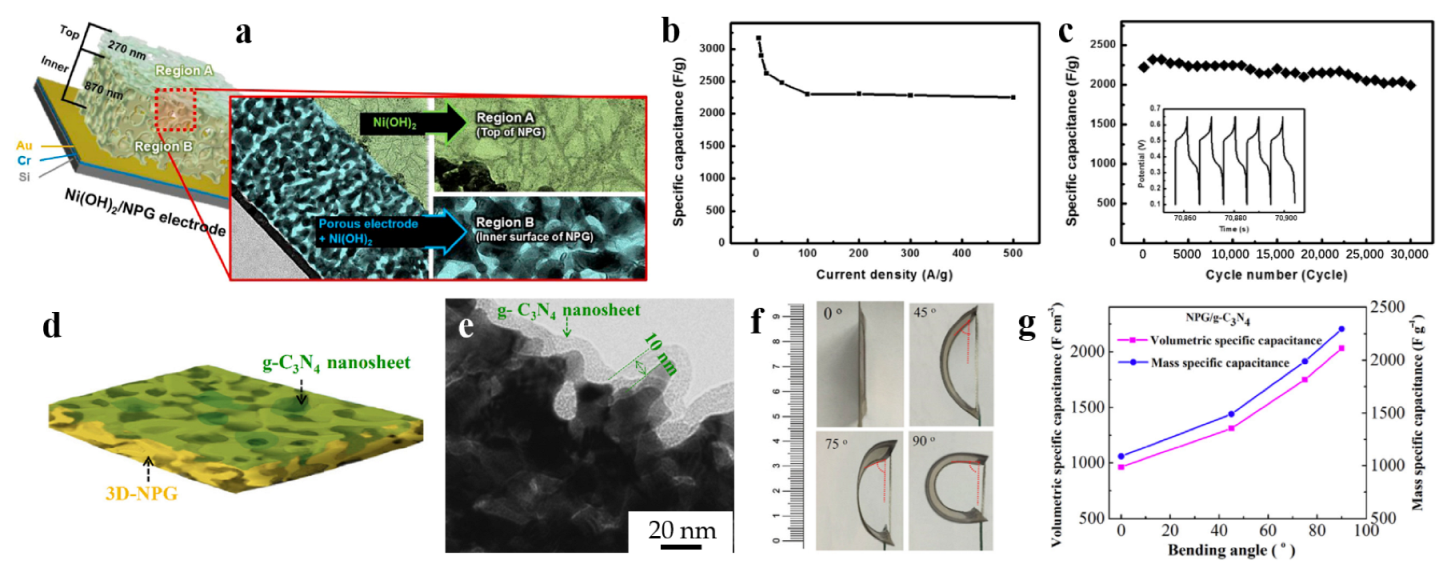
| Electrode | Specific Capacitance (Scan Rate or Current Density) | Capacitance Retention (Cycles, Scan Rate or Current Density) | Energy Density | Power Density | Function of NPG | Ref. |
|---|---|---|---|---|---|---|
| NPG/MnO2 | 1145 F/g | - | - | - | Increase electrical conductivity and ion diffusion rate, act as a double layer capacitor | [59] |
| nonaqueous MnO2@NPG | 160 F/g | - | - | - | Increase specific capacitance | [60] |
| MnO2/NPG/MnO2 | 841 F/g (5 mV/s) | 97.1% (3000, 50 mV/s) | - | - | Support and current collector | [61] |
| MnO2/graphene | 310 F/g (2 mV/s) | - | - | - | - | |
| Co3O4–MnO2–Au layered electrode | 1215 F/g (5 mV/s) | 83% (2000, 100 mV/s) | 24.37 Wh/kg | 1403 W/kg | Improve ionic conductivity and increase contact area | [62] |
| Co3O4+MnO2—Au hybrid electrode | 1334 F/g (5 mV/s) | 85% (2000, 100 mV/s) | 48.1 Wh/kg | 2524 W/kg | - | |
| RuO2@NPG | 1500 F/g (10 mV/s) | - | 50.3 Wh/kg | 84 kW/kg | Support and current collector | [63] |
| NPG/PANI | 1500 F/cm3 | - | 0.078 Wh/cm3 | - | - | [64] |
| RuO2–NPG//Co(OH)2–NPG | 350 F/g | 78% (3000) | 120 Wh/kg | - | - | [65] |
| NPG/VA Ni(OH)2 | 2911 F/cm3 | - | 31.4 Wh/kg | 100 kW/kg | - | [66] |
| Ni(OH)2/NPG | 2223 F/cm3 (5 A/g) | 90% (30,000, 500 A/g) | 98 Wh/kg | 50 kW/kg | Current Collector | [67] |
| PPy–NPG//MnO2–NPG | 193 F/g | 85% (2000, 100 mV/s) | 86 Wh/kg | 25 kW/kg | Support and current collector | [68] |
| PPy–3DrGO/NPG | 245.34 F/cm3 | 85.9% (10,000) | 98.48 mWh/cm3 | 19.68 W/cm3 | - | [70] |
| rGO-PPy/NPG | 55.6 F/cm3 | 91% (2000) | 238.8 mWh/cm3 | - | - | [71] |
| PANI/NPG | 6.54 mF/cm2 | - | 9.11 mWh/cm2 | 1.56 W/cm2 | - | [72] |
| NPG/g–C3N4 | 440 F/g (2 A/g) | 98% (10,000) | - | - | - | [73] |
3.4. Battery
3.5. CO2 Reduction Reaction
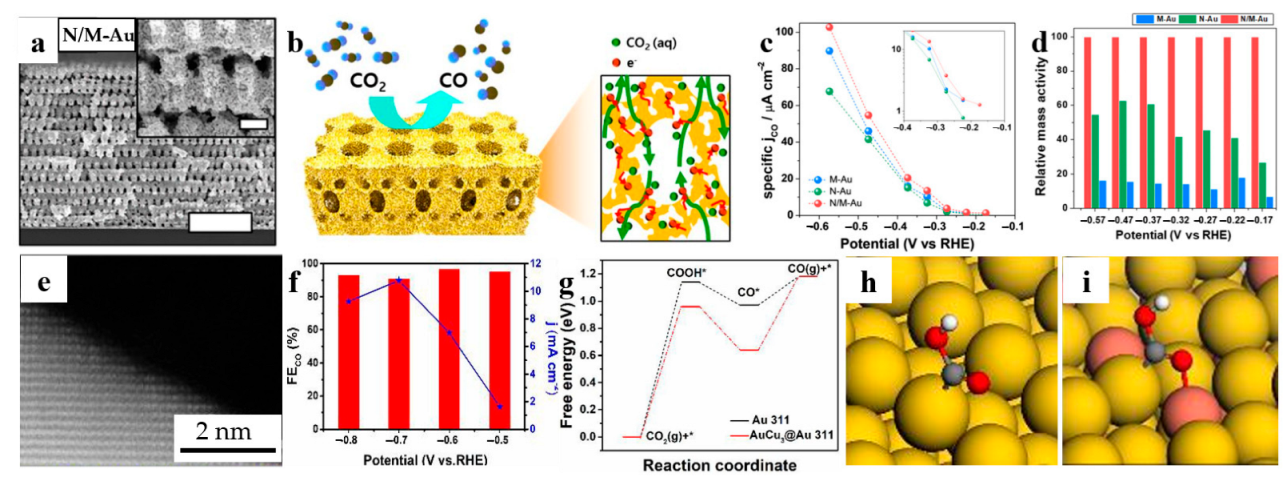
| Catalyst | jCO (mA/cm2) | Overpotential (mV) | Faradaic Efficiency | Current Densities (mA/cm2) | Tafel Slope (mV/Decade) | Ref. |
|---|---|---|---|---|---|---|
| pc-NPG | - | 390 | 98% | - | 52 | [37] |
| cd-NPG | - | - | - | - | 70 | |
| N-Au | 0.759 | - | - | −13.2 | 106 | [93] |
| M-Au | - | - | - | −12.6 | 120 | |
| N/M-Au | 0.891 | - | - | −19 | 107 | |
| NP Au-Sn | - | - | 86.5% at −0.8 V | - | - | [94] |
| NP Au3Cu | - | - | 98.12% at −0.7 V vs. RHE | 12.77 | - | [95] |
| NP AuCu3@Au | - | - | 97.27% at −0.6 V vs. RHE | 10.78 | - | [96] |
4. Summary and Outlook
- About water splitting, researchers make use of the advantages of the geometric structure of NPG and good electrical conductivity, combined with non-precious metal catalysts, to design low-cost, high-activity catalysts that can significantly reduce HER and OER overpotential and accelerate the reaction kinetics process.
- Regarding fuel cells, studies have focused on reducing Pt loading and improving fuel oxidation and ORR catalyst stability, and the good adaptability of NPG to Pt makes it a better loading material than carbon. To this end, the effects of NPG surface structure, localized surface plasmon resonance excitation and synergistic effects between Au and Pt, Pd and Cu on fuel oxidation and ORR catalytic activity have been mainly investigated.
- For supercapacitors, various structures of NPG hybrid electrodes have been designed to improve capacitance and cycling stability. Among them, the electrodes compounded with NPG and conducting polymers are lightweight and flexible, which have broad application prospects in wearable devices.
- In battery research, on the one hand, NPG is used as a classical model to study the existing problems of volume variation and stability of alloy-type LIB anodes; On the other hand, NPG is employed as an electrode material in various types of lithium batteries and metal-air cells to improve cell performance, such as reducing volume change, inhibiting lithium dendrite growth, extending electrode lifespan, etc.
- For CO2RR, the works mainly revolve around the preparation methods of NPG catalysts capable of efficient mass transport and CO selectivity and the catalytic mechanism of NPG-based alloy catalysts.
- High cost: The limited global reserves of gold contribute to its status as a precious metal, resulting in a relatively high cost. The production of NPG involves the use of gold alloys as raw materials and specialized manufacturing techniques, which further contribute to the higher production costs associated with NPG.
- Complex manufacturing process: To produce NPG-based materials with desired functionalities, it is necessary to finely tune the pore size and porosity of NPG. This involves careful control of various reaction conditions during the dealloying process, including selection of precursors, electrolytes, applied potentials, temperature, and duration. Additionally, factors such as coarsening after dealloying, surface adsorption, and surface coating treatment play a role in achieving the desired properties. As a result, the process of obtaining NPG with specific characteristics is intricate and requires attention to multiple variables and steps.
- Environmental hazard: Dealloying processes typically involve the use of strong acid or strong alkali solutions, which possess a certain degree of toxicity. Improper handling of these reagents can lead to environmental pollution and pose health risks to operators. Therefore, it is crucial to address the issue of waste liquid treatment and expedite the development of dealloying technologies that can be conducted under neutral and mild conditions.
Author Contributions
Funding
Data Availability Statement
Conflicts of Interest
References
- An, Y.; Tian, Y.; Wei, C.; Tao, Y.; Xi, B.; Xiong, S.; Feng, J.; Qian, Y. Dealloying: An effective method for scalable fabrication of 0D, 1D, 2D, 3D materials and its application in energy storage. Nano Today 2021, 37, 101094. [Google Scholar] [CrossRef]
- Fu, J.; Welborn, S.S.; Detsi, E. Dealloyed air- and water-sensitive nanoporous metals and metalloids for emerging energy applications. ACS Appl. Energy Mater. 2022, 5, 6516–6544. [Google Scholar] [CrossRef]
- Xi, W.; Wang, K.; Shen, Y.; Ge, M.; Deng, Z.; Zhao, Y.; Cao, Q.; Ding, Y.; Hu, G.; Luo, J. Dynamic co-catalysis of Au single atoms and nanoporous Au for methane pyrolysis. Nat. Commun. 2020, 11, 1919. [Google Scholar] [CrossRef] [PubMed]
- Huang, J.; Tang, C.; Chen, G.; He, Z.; Wang, T.; He, X.; Yi, T.; Liu, Y.; Zhang, L.; Du, K. Toward the limitation of dealloying: Full spectrum responsive ultralow density nanoporous gold for plasmonic photocatalytic SERS. ACS Appl. Mater. Interfaces 2021, 13, 7735–7744. [Google Scholar] [CrossRef]
- Yu, T.; Zhou, X.; Chen, Y.; Chen, J.; Yuan, S.; Qian, L.; Lu, X.; Liu, P.; Lei, P.; Li, X. Intrinsic contribution of mass transport within nanoscale channels of nanoporous gold for CO2 electrochemical reduction. Adv. Mater. Interfaces 2022, 9, 2200895. [Google Scholar] [CrossRef]
- Liu, Y.; Ding, J.; Li, F.; Su, X.; Zhang, Q.; Guan, G.; Hu, F.; Zhang, J.; Wang, Q.; Jiang, Y. Modulating hydrogen adsorption via charge transfer at the semiconductor–metal heterointerface for highly efficient hydrogen evolution catalysis. Adv. Mater. 2023, 35, 2207114. [Google Scholar] [CrossRef]
- Yu, T.; Zhou, X.; Chen, Y.; Chen, J.; Yuan, S.; Zhang, Z.; Qian, L.; Li, S. Robust catalysis of hierarchically nanoporous gold for CO2 electrochemical reduction. Electrochim. Acta 2023, 437, 141537. [Google Scholar] [CrossRef]
- Cheng, C.; Lührs, L. Robust metallic actuators based on nanoporous gold rapidly dealloyed from gold–nickel precursors. Adv. Funct. Mater. 2021, 31, 2107241. [Google Scholar] [CrossRef]
- Corsi, J.S.; Welborn, S.S.; Stach, E.A.; Detsi, E. Insights into the degradation mechanism of nanoporous alloy-type Li-ion battery anodes. ACS Energy Lett. 2021, 6, 1749–1756. [Google Scholar] [CrossRef]
- Kim, S.H. Nanoporous gold for energy applications. Chem. Rec. 2021, 21, 1199–1215. [Google Scholar] [CrossRef]
- Wang, M.; Meng, A.C.; Fu, J.; Foucher, A.C.; Serra-Maia, R.; Stach, E.A.; Detsi, E.; Pikul, J.H. Surface facet engineering in nanoporous gold for low-loading catalysts in aluminum-air batteries. ACS Appl. Mater. Interfaces 2021, 13, 13097–13105. [Google Scholar] [CrossRef]
- Li, J.; Li, L.Y.; Jia, P.; Okulov, I.V. Electrochemical behavior of nanoporous gold/polypyrrole supercapacitor under deformation. Nanomaterials 2022, 12, 2149. [Google Scholar] [CrossRef]
- Downs, A.M.; Gerson, J.; Hossain, M.N.; Ploense, K.; Pham, M.; Kraatz, H.B.; Kippin, T.; Plaxco, K.W. Nanoporous gold for the miniaturization of in vivo electrochemical aptamer-based sensors. ACS Sens. 2021, 6, 2299–2306. [Google Scholar] [CrossRef]
- Cai, J.; Zhang, W.; Xu, L.; Hao, C.; Ma, W.; Sun, M.; Wu, X.; Qin, X.; Colombari, F.M.; de Moura, A.F.; et al. Polarization-sensitive optoionic membranes from chiral plasmonic nanoparticles. Nat. Nanotechnol. 2022, 17, 408–416. [Google Scholar] [CrossRef]
- Tortolini, C.; Cass, A.E.G.; Pofi, R.; Lenzi, A.; Antiochia, R. Microneedle-based nanoporous gold electrochemical sensor for real-time catecholamine detection. Mikrochim. Acta 2022, 189, 180. [Google Scholar] [CrossRef] [PubMed]
- Wan, H.; Ma, W.; Zhou, K.; Cao, Y.; Liu, X.; Ma, R. Advanced silicon nanostructures derived from natural silicate minerals for energy storage and conversion. Green Energy Environ. 2022, 7, 205–220. [Google Scholar] [CrossRef]
- Ng, S.; Pumera, M. 2D functionalized germananes: Synthesis and applications. Adv. Mater. 2022, 35, 2207196. [Google Scholar] [CrossRef] [PubMed]
- Wu, X.; Lan, X.; Hu, R.; Yao, Y.; Yu, Y.; Zhu, M. Tin-based anode materials for stable sodium storage: Progress and perspective. Adv. Mater. 2022, 34, 2106895. [Google Scholar] [CrossRef]
- Jiang, M.; Danilov, D.L.; Eichel, R.A.; Notten, P.H.L. A review of degradation mechanisms and recent achievements for Ni-rich cathode-based Li-ion batteries. Adv. Energy Mater. 2021, 11, 2103005. [Google Scholar] [CrossRef]
- Lan, X.; Xiong, X.; Liu, J.; Yuan, B.; Hu, R.; Zhu, M. Insight into reversible conversion reactions in SnO2-based anodes for lithium storage: A review. Small 2022, 18, 2201110. [Google Scholar] [CrossRef]
- Lichchhavi; Kanwade, A.; Shirage, P.M. A review on synergy of transition metal oxide nanostructured materials: Effective and coherent choice for supercapacitor electrodes. J. Energy Storage 2022, 55, 105692. [Google Scholar] [CrossRef]
- Huang, B.; Zhao, Y. Iridium-based electrocatalysts toward sustainable energy conversion. EcoMat 2022, 4, e12176. [Google Scholar] [CrossRef]
- Du, R.; Jin, X.; Hübner, R.; Fan, X.; Hu, Y.; Eychmüller, A. Engineering self-supported noble metal foams toward electrocatalysis and beyond. Adv. Energy Mater. 2019, 10, 1901945. [Google Scholar] [CrossRef]
- Koya, A.N.; Zhu, X.; Ohannesian, N.; Yanik, A.A.; Alabastri, A.; Proietti Zaccaria, R.; Krahne, R.; Shih, W.C.; Garoli, D. Nanoporous metals: From plasmonic properties to applications in enhanced spectroscopy and photocatalysis. ACS Nano 2021, 15, 6038–6060. [Google Scholar] [CrossRef] [PubMed]
- Sondhi, P.; Lingden, D.; Bhattarai, J.K.; Demchenko, A.V.; Stine, K.J. Applications of nanoporous gold in therapy, drug delivery, and diagnostics. Metals 2022, 13, 78. [Google Scholar] [CrossRef]
- Pan, J.; Xu, W.; Li, W.; Chen, S.; Dai, Y.; Yu, S.; Zhou, Q.; Xia, F. Electrochemical aptamer-based sensors with tunable detection range. Anal. Chem. 2023, 95, 420–432. [Google Scholar] [CrossRef]
- Zhang, J.; Li, C.M. Nanoporous metals: Fabrication strategies and advanced electrochemical applications in catalysis, sensing and energy systems. Chem. Soc. Rev. 2012, 41, 7016–7031. [Google Scholar] [CrossRef]
- Chen, Q.; Ding, Y.; Chen, M. Nanoporous metal by dealloying for electrochemical energy conversion and storage. MRS Bull. 2018, 43, 43–48. [Google Scholar] [CrossRef]
- Wu, X.; He, G.; Ding, Y. Dealloyed nanoporous materials for rechargeable lithium batteries. Electrochem. Energy Rev. 2020, 3, 541–580. [Google Scholar] [CrossRef]
- Gonçalves, J.M.; Kumar, A.; da Silva, M.I.; Toma, H.E.; Martins, P.R.; Araki, K.; Bertotti, M.; Angnes, L. Nanoporous gold-based materials for electrochemical energy storage and conversion. Energy Technol. 2021, 9, 2000927. [Google Scholar] [CrossRef]
- McCue, I.; Benn, E.; Gaskey, B.; Erlebacher, J. Dealloying and Dealloyed Materials. Annu. Rev. Mater. Res. 2016, 46, 263–286. [Google Scholar] [CrossRef]
- Erlebacher, J.; Aziz, M.; Karma, A.; Dimitrov, N.; Sieradzki, K. Evolution of Nanoporosity in Dealloying. Nature 2001, 410, 450–453. [Google Scholar] [CrossRef] [PubMed]
- Ding, Y.; Kim, Y.J.; Erlebacher, J. Nanoporous Gold Leaf: “Ancient Technology”/Advanced Material. Adv. Mater. 2004, 16, 1897–1900. [Google Scholar] [CrossRef]
- Chen, Y.c.K.; Chu, Y.S.; Yi, J.; McNulty, I.; Shen, Q.; Voorhees, P.W.; Dunand, D.C. Morphological and topological analysis of coarsened nanoporous gold by x-ray nanotomography. Appl. Phys. Lett. 2010, 96, 043122. [Google Scholar] [CrossRef]
- Scaglione, F.; Alladio, E.; Damin, A.; Turci, F.; Baggiani, C.; Giovannoli, C.; Bordiga, S.; Battezzati, L.; Rizzi, P. Functionalized nanoporous gold as a new biosensor platform for ultra-low quantitative detection of human serum albumin. Sens. Actuators B Chem. 2019, 288, 460–468. [Google Scholar] [CrossRef]
- Yu, Q.; Yin, S.; Zhang, J.; Yin, H. Structure dependent activity and durability towards oxygen reduction reaction on Pt modified nanoporous gold. Electrochim. Acta 2019, 298, 599–608. [Google Scholar] [CrossRef]
- Lu, X.; Yu, T.; Wang, H.; Qian, L.; Lei, P. Electrochemical fabrication and reactivation of nanoporous gold with abundant surface steps for CO2 reduction. ACS Catal. 2020, 10, 8860–8869. [Google Scholar] [CrossRef]
- Sang, Q.; Hao, S.; Han, J.; Ding, Y. Dealloyed nanoporous materials for electrochemical energy conversion and storage. EnergyChem 2022, 4, 100069. [Google Scholar] [CrossRef]
- Tan, Y.; Liu, P.; Chen, L.; Cong, W.; Ito, Y.; Han, J.; Guo, X.; Tang, Z.; Fujita, T.; Hirata, A.; et al. Monolayer MoS2 films supported by 3D nanoporous metals for high-efficiency electrocatalytic hydrogen production. Adv. Mater. 2014, 26, 8023–8028. [Google Scholar] [CrossRef]
- Ge, X.; Chen, L.; Zhang, L.; Wen, Y.; Hirata, A.; Chen, M. Nanoporous metal enhanced catalytic activities of amorphous molybdenum sulfide for high-efficiency hydrogen production. Adv. Mater. 2014, 26, 3100–3104. [Google Scholar] [CrossRef]
- Bak, C.H.; Kim, K.; Jung, K.; Kim, J.B.; Jang, J.H. Efficient photoelectrochemical water splitting of nanostructured hematite on a three-dimensional nanoporous metal electrode. J. Mater. Chem. A 2014, 2, 17249–17252. [Google Scholar] [CrossRef]
- Huan, Y.; Shi, J.; Zou, X.; Gong, Y.; Zhang, Z.; Li, M.; Zhao, L.; Xu, R.; Jiang, S.; Zhou, X.; et al. Vertical 1T-TaS2 synthesis on nanoporous gold for high-performance electrocatalytic applications. Adv. Mater. 2018, 30, 1705916. [Google Scholar] [CrossRef] [PubMed]
- Zhang, Y.; Du, J.; Luo, R.; Wang, Z.; Wang, Z.; Han, J.; Liu, P.; Fujita, T.; Xue, Q.; Chen, M. 3D bicontinuous nanoporous plasmonic heterostructure for enhanced hydrogen evolution reaction under visible light. Nano Energy 2019, 58, 552–559. [Google Scholar] [CrossRef]
- Lu, X.; Yu, T.; Wang, H.; Luo, R.; Liu, P.; Yuan, S.; Qian, L. Self-supported nanoporous gold with gradient tin oxide for sustainable and efficient hydrogen evolution in neutral media. J. Renew. Mater. 2020, 8, 133–151. [Google Scholar] [CrossRef]
- Wang, Y.; Kim, J. Oxygen evolution reaction on nanoporous gold modified with Ir and Pt: Synergistic electrocatalysis between structure and composition. Electroanalysis 2019, 31, 1026–1033. [Google Scholar] [CrossRef]
- Sun, J.S.; Zhou, Y.T.; Yao, R.Q.; Shi, H.; Wen, Z.; Lang, X.Y.; Jiang, Q. Nanoporous gold supported chromium-doped NiFe oxyhydroxides as high-performance catalysts for the oxygen evolution reaction. J. Mater. Chem. A 2019, 7, 9690–9697. [Google Scholar] [CrossRef]
- Yao, R.Q.; Shi, H.; Wan, W.B.; Wen, Z.; Lang, X.Y.; Jiang, Q. Flexible Co-Mo-N/Au electrodes with a hierarchical nanoporous architecture as highly efficient electrocatalysts for oxygen evolution reaction. Adv. Mater. 2020, 32, 1907214. [Google Scholar] [CrossRef]
- Graf, M.; Vonbun-Feldbauer, G.B.; Koper, M.T.M. Direct and broadband plasmonic charge transfer to enhance water oxidation on a gold electrode. ACS Nano 2021, 15, 3188–3200. [Google Scholar] [CrossRef]
- Ding, Y.; Chen, M.W.; Erlebacher, J. Metallic mesoporous nanocomposites for electrocatalysis. J. Am. Chem. Soc. 2004, 126, 6876–6877. [Google Scholar] [CrossRef]
- Ge, X.B.; Wang, R.Y.; Liu, P.P.; Ding, Y. Platinum-decorated nanoporous gold leaf for methanol electrooxidation. Chem. Mater. 2007, 19, 5827–5829. [Google Scholar] [CrossRef]
- Wen, X.; Yin, S.; Yin, H.; Ding, Y. A displacement dealloying route to dilute nanoporous PtAu alloys for highly active formic acid electro-oxidation. Electrochim. Acta 2021, 373, 137884. [Google Scholar] [CrossRef]
- Chen, L.Y.; Chen, N.; Hou, Y.; Wang, Z.C.; Lv, S.H.; Fujita, T.; Jiang, J.H.; Hirata, A.; Chen, M.W. Geometrically controlled nanoporous PdAu bimetallic catalysts with tunable Pd/Au ratio for direct ethanol fuel cells. ACS Catal. 2013, 3, 1220–1230. [Google Scholar] [CrossRef]
- Xu, H.; Liu, S.; Pu, X.; Shen, K.; Zhang, L.; Wang, X.; Qin, J.; Wang, W. Dealloyed porous gold anchored by in situ generated graphene sheets as high activity catalyst for methanol electro-oxidation reaction. RSC Adv. 2020, 10, 1666–1678. [Google Scholar] [CrossRef]
- Wang, Z.; Ning, S.; Liu, P.; Ding, Y.; Hirata, A.; Fujita, T.; Chen, M. Tuning surface structure of 3D nanoporous gold by surfactant-free electrochemical potential cycling. Adv. Mater. 2017, 29, 1703601. [Google Scholar] [CrossRef]
- Wang, Z.; Du, J.; Zhang, Y.; Han, J.; Huang, S.; Hirata, A.; Chen, M. Free-standing nanoporous gold for direct plasmon enhanced electro-oxidation of alcohol molecules. Nano Energy 2019, 56, 286–293. [Google Scholar] [CrossRef]
- Xie, Y.; Dimitrov, N. Ultralow Pt loading nanoporous Au-Cu-Pt thin film as highly active and durable catalyst for formic acid oxidation. Appl. Catal. B Environ. 2020, 263, 118366. [Google Scholar] [CrossRef]
- Li, J.; Yin, H.M.; Li, X.B.; Okunishi, E.; Shen, Y.L.; He, J.; Tang, Z.K.; Wang, W.X.; Yücelen, E.; Li, C.; et al. Surface evolution of a Pt–Pd–Au electrocatalyst for stable oxygen reduction. Nat. Energy 2017, 2, 17111. [Google Scholar] [CrossRef]
- Zhang, J.; Yin, S.; Yin, H.M. Strain engineering to enhance the oxidation reduction reaction performance of atomic-layer Pt on nanoporous gold. ACS Appl. Energy Mater. 2020, 3, 11956–11963. [Google Scholar] [CrossRef]
- Lang, X.; Hirata, A.; Fujita, T.; Chen, M. Nanoporous metal/oxide hybrid electrodes for electrochemical supercapacitors. Nat. Nanotechnol. 2011, 6, 232–236. [Google Scholar] [CrossRef]
- Chen, L.Y.; Kang, J.L.; Hou, Y.; Liu, P.; Fujita, T.; Hirata, A.; Chen, M.W. High-energy-density nonaqueous MnO2@nanoporous gold based supercapacitors. J. Mater. Chem. A 2013, 1, 9202–9207. [Google Scholar] [CrossRef]
- Kang, J.; Chen, L.; Hou, Y.; Li, C.; Fujita, T.; Lang, X.; Hirata, A.; Chen, M. Electroplated thick manganese oxide films with ultrahigh capacitance. Adv. Energy Mater. 2013, 3, 857–863. [Google Scholar] [CrossRef]
- Prabhin, V.S.; Jeyasubramanian, K.; Benitha, V.S.; Veluswamy, P.; Cho, B.J. Fabrication and evaluation of hybrid supercapacitor consisting of nano cobalt oxide and manganese oxide deposited electrochemically on nanoporous Au-Electrode. Electrochim. Acta 2020, 330, 135199. [Google Scholar] [CrossRef]
- Chen, L.Y.; Hou, Y.; Kang, J.L.; Hirata, A.; Fujita, T.; Chen, M.W. Toward the theoretical capacitance of RuO2 reinforced by highly conductive nanoporous gold. Adv. Energy Mater. 2013, 3, 851–856. [Google Scholar] [CrossRef]
- Lang, X.; Zhang, L.; Fujita, T.; Ding, Y.; Chen, M. Three-dimensional bicontinuous nanoporous Au/polyaniline hybrid films for high-performance electrochemical supercapacitors. J. Power Sources 2012, 197, 325–329. [Google Scholar] [CrossRef]
- Chen, L.Y.; Hou, Y.; Kang, J.L.; Hirata, A.; Chen, M.W. Asymmetric metal oxide pseudocapacitors advanced by three-dimensional nanoporous metal electrodes. J. Mater. Chem. A 2014, 2, 8448–8455. [Google Scholar] [CrossRef]
- Hou, C.; Lang, X.Y.; Wen, Z.; Zhu, Y.-F.; Zhao, M.; Li, J.C.; Zheng, W.-T.; Lian, J.S.; Jiang, Q. Single-crystalline Ni(OH)2 nanosheets vertically aligned on a three-dimensional nanoporous metal for high-performance asymmetric supercapacitors. J. Mater. Chem. A 2015, 3, 23412–23419. [Google Scholar] [CrossRef]
- Kim, S.I.; Kim, S.W.; Jung, K.; Kim, J.B.; Jang, J.H. Ideal nanoporous gold based supercapacitors with theoretical capacitance and high energy/power density. Nano Energy 2016, 24, 17–24. [Google Scholar] [CrossRef]
- Hou, Y.; Chen, L.; Liu, P.; Kang, J.; Fujita, T.; Chen, M. Nanoporous metal based flexible asymmetric pseudocapacitors. J. Mater. Chem. A 2014, 2, 10910–10916. [Google Scholar] [CrossRef]
- Zhang, C.; Xiao, J.; Qian, L.; Yuan, S.; Wang, S.; Lei, P. Planar integration of flexible micro-supercapacitors with ultrafast charge and discharge based on interdigital nanoporous gold electrodes on a chip. J. Mater. Chem. A 2016, 4, 9502–9510. [Google Scholar] [CrossRef]
- Purkait, T.; Singh, G.; Kamboj, N.; Das, M.; Dey, R.S. All-porous heterostructure of reduced graphene oxide–polypyrrole–nanoporous gold for a planar flexible supercapacitor showing outstanding volumetric capacitance and energy density. J. Mater. Chem. A 2018, 6, 22858–22869. [Google Scholar] [CrossRef]
- Yang, Y.; Zhang, J.; Zhang, H.; Hou, Y.; Guo, J. High-performance three-dimensional nanoporous gold based electrodes for flexible all-solid-state supercapacitors. J. Porous Mater. 2020, 27, 1309–1317. [Google Scholar] [CrossRef]
- Lee, K.U.; Byun, J.Y.; Shin, H.J.; Kim, S.H. A high-performance supercapacitor based on polyaniline-nanoporous gold. J. Alloys Compd. 2019, 779, 74–80. [Google Scholar] [CrossRef]
- Chen, A.Y.; Zhang, T.T.; Qiu, Y.J.; Wang, D.; Wang, P.; Li, H.J.; Li, Y.; Yang, J.H.; Wang, X.Y.; Xie, X.F. Construction of nanoporous gold/g-C3N4 heterostructure for electrochemical supercapacitor. Electrochim. Acta 2019, 294, 260–267. [Google Scholar] [CrossRef]
- Manthiram, A. A reflection on lithium-ion battery cathode chemistry. Nat. Commun. 2020, 11, 1550. [Google Scholar] [CrossRef] [PubMed]
- Wang, Z.; Yan, Y.; Zhang, Y.; Chen, Y.; Peng, X.; Wang, X.; Zhao, W.; Qin, C.; Liu, Q.; Liu, X.; et al. Single-atomic Co-B2N2 sites anchored on carbon nanotube arrays promote lithium polysulfide conversion in lithium–sulfur batteries. Carbon Energy 2023, e306. [Google Scholar] [CrossRef]
- Yu, Y.; Gu, L.; Lang, X.; Zhu, C.; Fujita, T.; Chen, M.; Maier, J. Li storage in 3D nanoporous Au-supported nanocrystalline tin. Adv. Mater. 2011, 23, 2443–2447. [Google Scholar] [CrossRef]
- Park, M.; Zhang, X.; Chung, M.; Less, G.B.; Sastry, A.M. A review of conduction phenomena in Li-ion batteries. J. Power Sources 2010, 195, 7904–7929. [Google Scholar] [CrossRef]
- Ye, J.C.; Baumgaertel, A.C.; Wang, Y.M.; Biener, J.; Biener, M.M. Structural optimization of 3D porous electrodes for high-rate performance lithium ion batteries. ACS Nano 2015, 9, 2194–2202. [Google Scholar] [CrossRef]
- Yang, C.; Fu, K.; Zhang, Y.; Hitz, E.; Hu, L. Protected lithium-metal anodes in batteries: From liquid to solid. Adv. Mater. 2017, 29, 1701169. [Google Scholar] [CrossRef]
- Kim, H.; Jeong, G.; Kim, Y.U.; Kim, J.H.; Park, C.M.; Sohn, H.J. Metallic anodes for next generation secondary batteries. Chem. Soc. Rev. 2013, 42, 9011–9034. [Google Scholar] [CrossRef]
- Cheng, X.B.; Zhang, R.; Zhao, C.Z.; Zhang, Q. Toward safe lithium metal anode in rechargeable batteries: A review. Chem. Rev. 2017, 117, 10403–10473. [Google Scholar] [CrossRef] [PubMed]
- Zheng, J.; Engelhard, M.H.; Mei, D.; Jiao, S.; Polzin, B.J.; Zhang, J.-G.; Xu, W. Electrolyte additive enabled fast charging and stable cycling lithium metal batteries. Nat. Energy 2017, 2, 17012. [Google Scholar] [CrossRef]
- Zhang, X.; Zhang, Q.; Wang, X.G.; Wang, C.; Chen, Y.N.; Xie, Z.; Zhou, Z. An extremely simple method for protecting lithium anodes in Li-O2 batteries. Angew. Chem. Int. Ed. Engl. 2018, 57, 12814–12818. [Google Scholar] [CrossRef]
- Liang, Y.; Chen, Y.; Ke, X.; Zhang, Z.; Wu, W.; Lin, G.; Zhou, Z.; Shi, Z. Coupling of triporosity and strong Au–Li interaction to enable dendrite-free lithium plating/stripping for long-life lithium metal anodes. J. Mater. Chem. A 2020, 8, 18094–18105. [Google Scholar] [CrossRef]
- Chen, Y.; Ke, X.; Cheng, Y.; Fan, M.; Wu, W.; Huang, X.; Liang, Y.; Zhong, Y.; Ao, Z.; Lai, Y.; et al. Boosting the electrochemical performance of 3D composite lithium metal anodes through synergistic structure and interface engineering. Energy Storage Mater. 2020, 26, 56–64. [Google Scholar] [CrossRef]
- Yan, K.; Lu, Z.; Lee, H.-W.; Xiong, F.; Hsu, P.-C.; Li, Y.; Zhao, J.; Chu, S.; Cui, Y. Selective deposition and stable encapsulation of lithium through heterogeneous seeded growth. Nat. Energy 2016, 1, 16010. [Google Scholar] [CrossRef]
- Chen, L.Y.; Guo, X.W.; Han, J.H.; Liu, P.; Xu, X.D.; Hirata, A.; Chen, M.W. Nanoporous metal/oxide hybrid materials for rechargeable lithium–oxygen batteries. J. Mater. Chem. A 2015, 3, 3620–3626. [Google Scholar] [CrossRef]
- Ma, W.; Liu, X.; Li, C.; Yin, H.; Xi, W.; Liu, R.; He, G.; Zhao, X.; Luo, J.; Ding, Y. Rechargeable Al-CO2 batteries for reversible utilization of CO2. Adv. Mater. 2018, 30, 1801152. [Google Scholar] [CrossRef]
- Yang, F.; Liu, J.; Lu, Z.; Dai, P.; Nakamura, T.; Wang, S.; Chen, L.; Wakamiya, A.; Matsuda, K. Recycled utilization of a nanoporous au electrode for reduced fabrication cost of perovskite solar cells. Adv. Sci. (Weinh) 2020, 7, 1902474. [Google Scholar] [CrossRef]
- Peng, Z.Q.; Freunberger, S.A.; Chen, Y.H.; Bruce, P.G. A Reversible and Higher-Rate Li-O2 Battery. Science 2012, 337, 563–566. [Google Scholar] [CrossRef]
- Guo, X.; Han, J.; Liu, P.; Chen, L.; Ito, Y.; Jian, Z.; Jin, T.; Hirata, A.; Li, F.; Fujita, T.; et al. Hierarchical nanoporosity enhanced reversible capacity of bicontinuous nanoporous metal based Li-O2 battery. Sci. Rep. 2016, 6, 33466. [Google Scholar] [CrossRef]
- Yang, H.; Xia, J.; Bromberg, L.; Dimitrov, N.; Whittingham, M.S. Electrochemically synthesized nanoporous gold as a cathode material for Li-O2 batteries. J. Solid State Electrochem. 2016, 21, 463–468. [Google Scholar] [CrossRef]
- Hyun, G.; Song, J.T.; Ahn, C.; Ham, Y.; Cho, D.; Oh, J.; Jeon, S. Hierarchically porous Au nanostructures with interconnected channels for efficient mass transport in electrocatalytic CO2 reduction. Proc. Natl. Acad. Sci. USA 2020, 117, 5680–5685. [Google Scholar] [CrossRef] [PubMed]
- Lu, X.; Yu, T.; Wang, H.; Qian, L.; Luo, R.; Liu, P.; Yu, Y.; Liu, L.; Lei, P.; Yuan, S. Nanoporous Au-Sn with solute strain for simultaneously enhanced selectivity and durability during electrochemical CO2 reduction. J. Mater. Sci. Technol. 2020, 43, 154–160. [Google Scholar] [CrossRef]
- Ma, X.; Shen, Y.; Yao, S.; Shu, M.; Si, R.; An, C. Self-supported nanoporous Au3Cu electrode with enriched gold on surface for efficient electrochemical reduction of CO2. Chemistry 2019, 26, 4143–4149. [Google Scholar] [CrossRef]
- Ma, X.; Shen, Y.; Yao, S.; An, C.; Zhang, W.; Zhu, J.; Si, R.; Guo, C.; An, C. Core–shell nanoporous AuCu3@Au monolithic electrode for efficient electrochemical CO2 reduction. J. Mater. Chem. A 2020, 8, 3344–3350. [Google Scholar] [CrossRef]
- Liu, Z.; Hossain, M.N.; Wen, J.; Chen, A. Copper decorated with nanoporous gold by galvanic displacement acts as an efficient electrocatalyst for the electrochemical reduction of CO2. Nanoscale 2021, 13, 1155–1163. [Google Scholar] [CrossRef] [PubMed]
- Wang, Z.; Zhang, X.; Liu, X.; Zhang, W.; Zhang, Y.; Li, Y.; Qin, C.; Zhao, W.; Bakenov, Z. Dual-network nanoporous NiFe2O4/NiO composites for high performance Li-ion battery anodes. Chem. Eng. J. 2020, 388, 124207. [Google Scholar] [CrossRef]
- Liu, S.; Pang, F.; Zhang, Q.; Guo, R.; Wang, Z.; Wang, Y.; Zhang, W.; Ou, J. Stable nanoporous Sn/SnO2 composites for efficient electroreduction of CO2 to formate over wide potential range. Appl. Mater. Today 2018, 13, 135–143. [Google Scholar] [CrossRef]
- Yan, Y.; Liu, Y.; Zhang, Y.; Qin, C.; Bakenov, Z.; Wang, Z. Improving the cycling stability of three-dimensional nanoporous Ge anode by embedding Ag nanoparticles for high-performance lithium-ion battery. J. Colloid Interface Sci. 2021, 592, 103–115. [Google Scholar] [CrossRef]
- Tan, H.W.; Choong, Y.Y.C.; Kuo, C.N.; Low, H.Y.; Chua, C.K. 3D printed electronics: Processes, materials and future trends. Prog. Mater. Sci. 2022, 127, 100945. [Google Scholar] [CrossRef]
- Ma, H.; Chen, Z.; Wang, Z. Electroreduction of nitrogen to ammonia on nanoporous gold. Nanoscale 2021, 13, 1717–1722. [Google Scholar] [CrossRef] [PubMed]
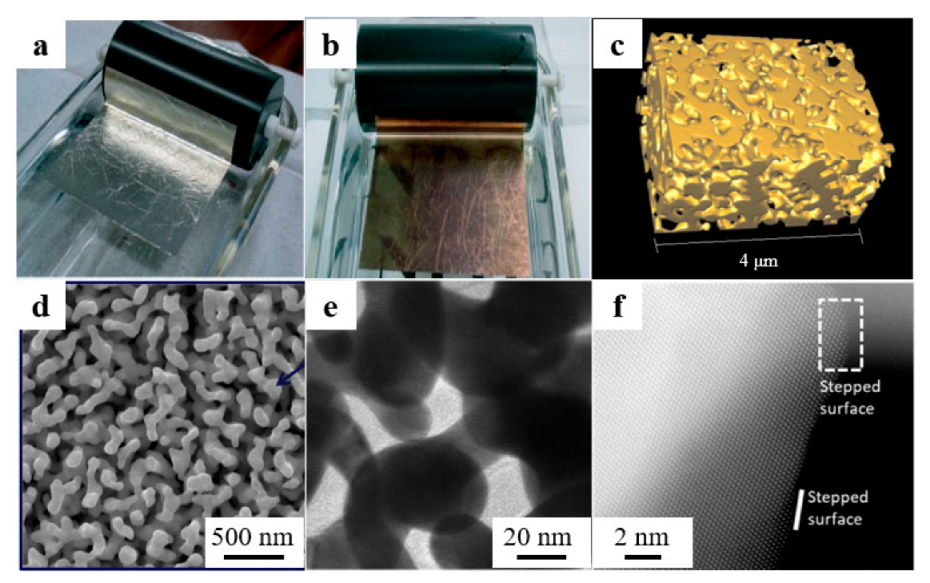
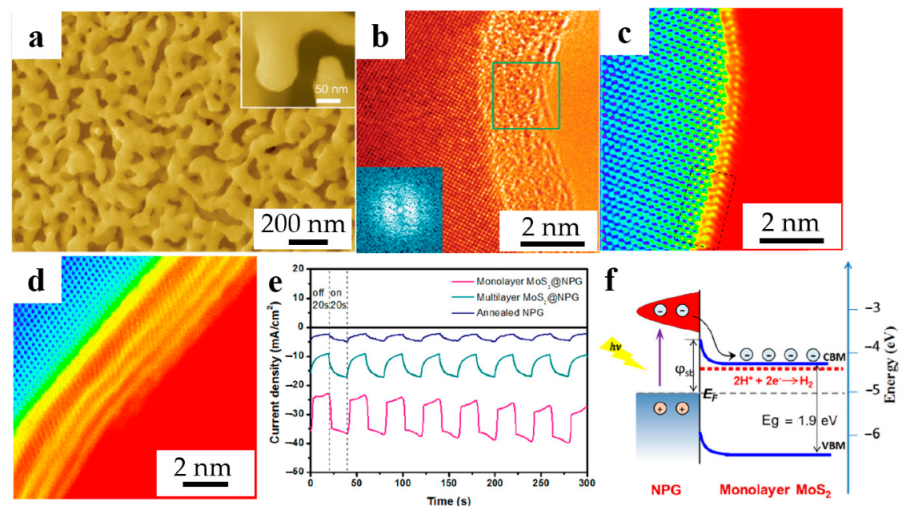
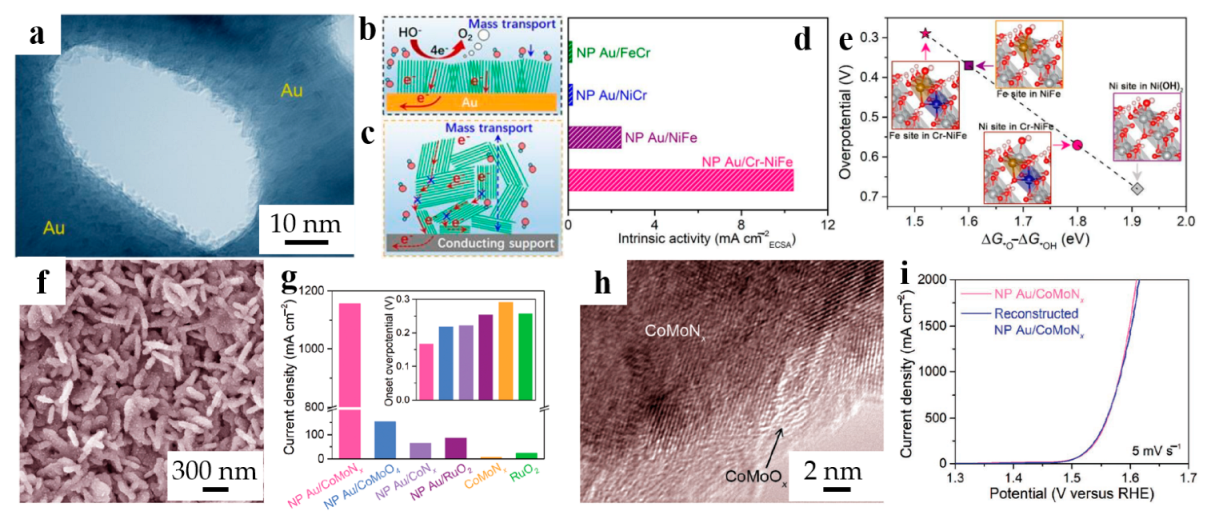
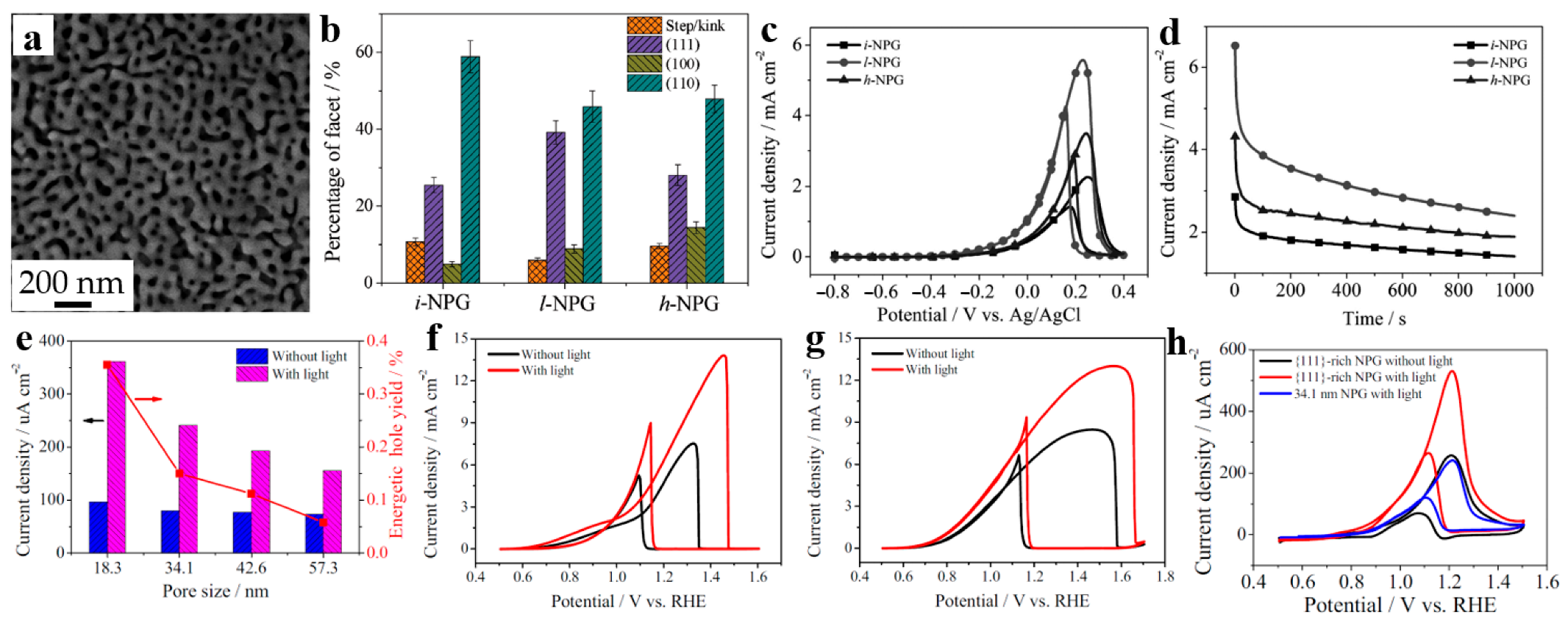
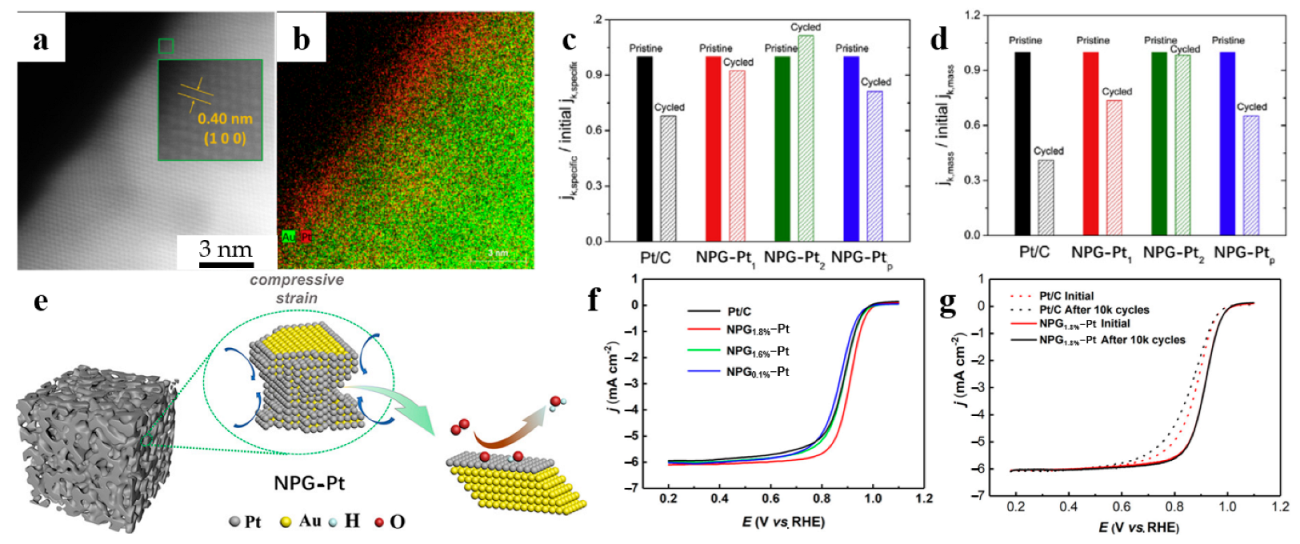
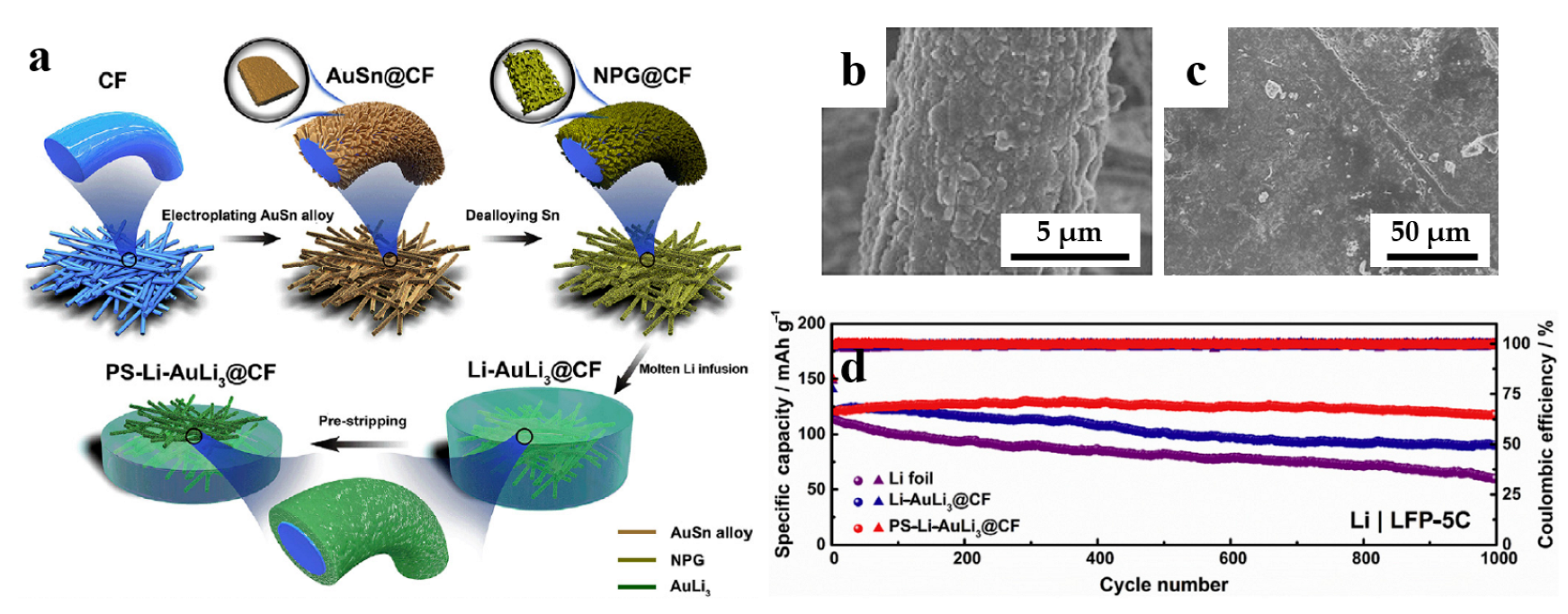
| Catalyst | Solution | Onset Overpotential (mV) | Onset HER Potentials (mV vs. RHE) | Current Densities (mA/cm2, vs. RHE) | Tafel Slope (mV/Decade) | Function of NPG | Ref. |
|---|---|---|---|---|---|---|---|
| 1L MoS2 @NPG | 0.5 M H2SO4 | 118 | - | 0.52 at 0.25 V | 46 | High conductivity and large surface area | [39] |
| 2L MoS2 @NPG | 128 | - | - | 52 | |||
| 3L MoS2 @NPG | 132 | - | - | 55 | |||
| NPG | - | −145 | −0.2 at −0.2 V | 95 | [40] | ||
| MoS2.7 @GCE | - | −143 | −0.9 | - | |||
| MoS2.7 @NPG | - | −125 | −5.7 | 41 | |||
| α-Fe2O3/NPG | 1 M NaOH | - | - | 1.6 at 1.5 V | - | Current collector and efficient pathways for charge transportation | [41] |
| 1T-TaS2 | - | - | - | 0.06761 | 67–82 | Inducing growth of 1T-TaS2 nanosheets along vertical orientation | [42] |
| MoS2 @NPG | 0.5 M H2SO4 | - | −70 | - | 38 | Form strong LSPR | [43] |
| NPG-SnOx | 0.2 M PBS | 38 | - | 10 | 79 | Build metal/oxide interfaces | [44] |
| Catalyst | Solution | Overpotential | Tafel Slope (mV/Decade) | Function of NPG | Ref. |
|---|---|---|---|---|---|
| NPG/Cr-NiFe | 0.1 M KOH | 323 mV at 10 mA/cm2 | 33 | Provides electrolyte and electron pathways along nanopore channels and Au ligaments | [46] |
| NPG/CoMoNx | 1 M KOH | 370 mV at 1156 mA/cm2 | 46 | Facilitate electron transfer and mass transport | [47] |
| NPG@Pt | 0.1 M HClO4 | −300 mV | 225 | [45] | |
| flat Pt | - | 195 | |||
| NPG | 0 | 276 | |||
| NPG@Ir | −370 mV | 62 | |||
| flat Ir | - | 59 |
| Catalyst | Mass Activity (vs. Pt/C) | Onset Potentials (V vs. Ag-AgCl) | Current Densities (mA/cm2) | Function of NPG | Application | Ref. |
|---|---|---|---|---|---|---|
| NP PtAu | 70 at 0.6 V vs. RHE | - | - | Synergistic catalysis with Pt | formic acid electro-oxidation | [51] |
| Pt/C | 1 | - | - | - | ||
| NP-Pd75Au25 | - | −0.58 | 6.95 | Enhance catalytic activity and selectivity as well as the resistance to poisoning | ethanol electrooxidation | [52] |
| NP-Pd | - | −0.52 | 2.65 | - | ||
| NP-Au | - | −0.1 | 0.69 | - | ||
| Pt/C | - | −0.58 | 3.02 | - | ||
| {111}-rich l-NPG | - | −0.33 | 5.5 | Catalyst | ethanol oxidation | [54] |
| {100}-rich h-NPG | - | −0.26 | 3.5 | |||
| {110}-rich i-NPG | - | −0.24 | 2.2 | |||
| NP Au-Cu-Pt | 250 at 0.0 V/MSE | - | - | formic acid oxidation | [56] |
| Catalyst | Mass Activity (A/mgPt at 0.9V) | Onset Overpotential (V at 0.1 mA/cm2) | Current Densities (mA/cm2) | Tafel Slope (mV/Decade) | Ref. |
|---|---|---|---|---|---|
| NPG-Pt1 | 2.16 | 0.98 | - | - | [36] |
| NPG-Pt2 | 1.16 | 1 | - | - | |
| NPG-Ptp | 0.46 | 1.04 | - | - | |
| NPG-Pd-Pt | 1.14 | - | 0.58 | - | [57] |
| NPG-Pt | - | - | 0.287 | - | |
| NPG-Pd-Pt30,000 | 1.471 | - | - | - | |
| Pt/C | 0.17 | - | 0.138 | 69.5 | |
| NPG-0.1%-Pt | 1.15 | - | - | 70 | [58] |
| NPG1.6%-Pt | 1.97 | - | - | 69.4 | |
| NPG1.8%-Pt | 3.04 | - | - | 68.8 |
| Battery Type | Anode | Cathode | Initial Capacity | Reversible Capacity at Discharge Rate (Number of Cycles) | Capacity% Retention (Number of Cycles) | Function of NPG | Ref. |
|---|---|---|---|---|---|---|---|
| Li-ion battery | NPG | Lithium foil | 810 mAh/g | 35 mAh/g at 0.1 C (70) | - | Support, increase contact area, increase ion and electron transport rates, accommodate large volume changes | [76] |
| NPG/Sn | Lithium foil | 756 mAh/g | 620 mAh/g at 0.1 C (140) | 95.9% (140) | Current collector | ||
| TiO2/NPG | Li | - | 227 mAh/g at 16.8 mA/g | - | Monolithic metallic scaffold and current collector. | [78] | |
| Li-metal battery | PS-Li-AuLi3@CF | LPF | 122 mAh/g | 117 mAh/g (1000) | 96.1 at 5 C (1000) | Lithiophilic phase (suppresses Li dendrite growth and dead Li formation) | [85] |
| PS-Li-AuLi3@CF | SPAN | 637 mAh/g | 70.6 at 2 C (1000) | ||||
| NPAuLi3@NF | LPF | 149.1 mAh/g | 108.4 mAh/g (1000) | 83.8 at 5 C (1000) | [86] | ||
| Li-O2 battery | Li | NPG | - | 300 mAh/g at 500 mA/g | 95 (100) | Lower the charging voltage | [90] |
| Li | RuO2-NPG | - | 300 mAh/g at 50 mA/g (50) | - | Improving the conductivity and catalytic activity of insulating oxides | [87] | |
| Li | h-NPG | - | 1500 mAh/g at 2.0 A/g (140) | - | Current collector and high-performance cathode | [91] | |
| LPF | NPG/Au | - | 1380 mAh/cm3 | - | Improve the reversibility and kinetics of Li-O2 batteries | [92] | |
| Al-CO2 battery | Al | NPG@Pd | - | - | - | Current collector | [88] |
| Al-air battery | Al | NPG/C | - | 2052 mAh/g at 50 mA/cm2 | - | Catalyst | [11] |
Disclaimer/Publisher’s Note: The statements, opinions and data contained in all publications are solely those of the individual author(s) and contributor(s) and not of MDPI and/or the editor(s). MDPI and/or the editor(s) disclaim responsibility for any injury to people or property resulting from any ideas, methods, instructions or products referred to in the content. |
© 2023 by the authors. Licensee MDPI, Basel, Switzerland. This article is an open access article distributed under the terms and conditions of the Creative Commons Attribution (CC BY) license (https://creativecommons.org/licenses/by/4.0/).
Share and Cite
Yu, M.; Wu, X.; Qin, C.; Wang, Z. Dealloyed Nanoporous Gold-Based Materials for Energy Storage and Conversion. Metals 2023, 13, 1298. https://doi.org/10.3390/met13071298
Yu M, Wu X, Qin C, Wang Z. Dealloyed Nanoporous Gold-Based Materials for Energy Storage and Conversion. Metals. 2023; 13(7):1298. https://doi.org/10.3390/met13071298
Chicago/Turabian StyleYu, Mengdan, Xiaoyu Wu, Chunling Qin, and Zhifeng Wang. 2023. "Dealloyed Nanoporous Gold-Based Materials for Energy Storage and Conversion" Metals 13, no. 7: 1298. https://doi.org/10.3390/met13071298
APA StyleYu, M., Wu, X., Qin, C., & Wang, Z. (2023). Dealloyed Nanoporous Gold-Based Materials for Energy Storage and Conversion. Metals, 13(7), 1298. https://doi.org/10.3390/met13071298







